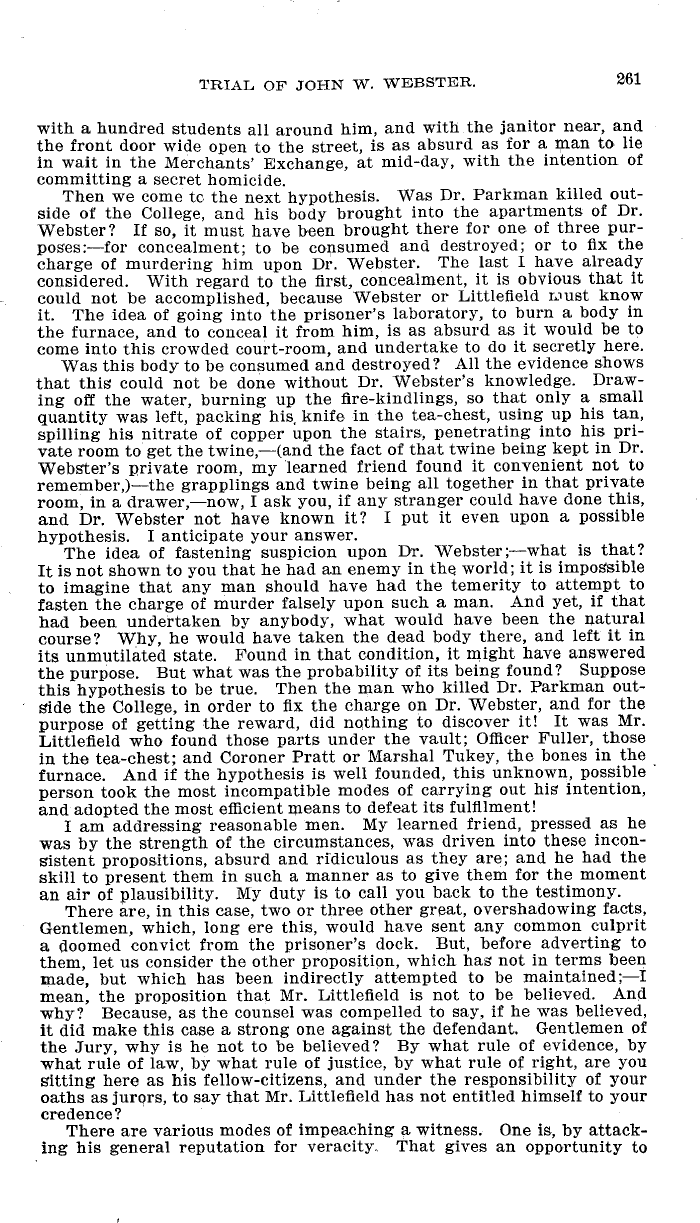|
TRIAL OF JOHN W. WEBSTER. 261
with a hundred students all around him, and with the janitor near, and
the front door wide open to the street, is as absurd as for a man to lie
in wait in the Merchants' Exchange, at mid-day, with the intention of
committing a secret homicide.
Then we come tc. the next hypothesis. Was Dr. Parkman killed out-
side of the College, and his body brought into the apartments of Dr.
Webster? If so, it must have been brought there for one of three pur-
poses:-for concealment; to be consumed and destroyed; or to fix the
charge of murdering him upon Dr. Webster. The last I have already
considered. With regard to the first, concealment, it is obvious that it
could not be accomplished, because Webster or Littlefield ro ust know
it. The idea of going into the prisoner's laboratory, to burn a body in
the furnace, and to conceal it from him, is as absurd as it would be to
come into this crowded court-room, and undertake to do it secretly here.
Was this body to be consumed and destroyed? All the evidence shows
that this could not be done without Dr. Webster's knowledge. Draw-
ing off the water, burning up the fire-kindlings, so that only a small
quantity was left, packing his knife in the tea-chest, using up his tan,
spilling his nitrate of copper upon the stairs, penetrating into his pri-
vate room to get the twine,-(and the fact of that twine being kept in Dr.
Webster's private room, my learned friend found it convenient not to
remember,)-the grapplings and twine being all together in that private
room, in a drawer,-now, I ask you, if any stranger could have done this,
and Dr. Webster not have known it? I put it even upon a possible
hypothesis. I anticipate your answer.
The idea of fastening suspicion upon Dr. Webster; what is that?
It is not shown to you that he had an enemy in the world; it is impossible
to imagine that any man should have had the temerity to attempt to
fasten the charge of murder falsely upon such a man. And yet, if that
had been undertaken by anybody, what would have been the natural
course? Why, he would have taken the dead body there, and left it in
its unmutilated state. Found in that condition, it might have answered
the purpose. But what was the probability of its being found? Suppose
this hypothesis to be true. Then the man who killed Dr. Parkman out-
side the College, in order to fix the charge on Dr. Webster, and for the
purpose of getting the reward, did nothing to discover it! It was Mr.
Littlefield who found those parts under the vault; Officer Fuller, those
in the tea-chest; and Coroner Pratt or Marshal Tukey, the bones in the
furnace. And if the hypothesis is well founded, this unknown, possible
person took the most incompatible modes of carrying out big intention,
and adopted the most efficient means to defeat its fulfilment!
I am addressing reasonable men. My learned friend, pressed as he
was by the strength of the circumstances, was driven into these incon-
sistent propositions, absurd and ridiculous as they are; and he had the
skill to present them in such a manner as to give them for the moment
an air of plausibility. My duty is to call you back to the testimony.
There are, in this case, two or three other great, overshadowing facts,
Gentlemen, which, long ere this, would have sent any common culprit
a doomed convict from the prisoner's dock. But, before adverting to
them, let us consider the other proposition, which hag not in terms been
made, but which has been indirectly attempted to be maintained; -I
mean, the proposition that Mr. Littlefield is not to be believed. And
why? Because, as the counsel was compelled to say, if he was believed,
it did make this case a strong one against the defendant. Gentlemen of
the Jury, why is he not to be believed? By what rule of evidence, by
what rule of law, by what rule of justice, by what rule of right, are you
sitting here as his fellow-citizens, and under the responsibility of your
oaths as jurors, to say that Mr. Littlefield has not entitled himself to
your
credence?
There are various modes of impeaching a witness. One is, by attack-
ing his general reputation for veracity. That gives an opportunity to
|

